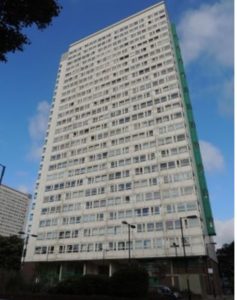Stop the top-down public health approach – talk to the communities!

While its fantastic to see and hear the singing from lockdowns in Italy. The reality, for many, will be very different. Many of our council estates are not suitable for isolation. I lived in this block for 20 years. On the Pepys Estate in Deptford. The community is brilliant. It has a long tradition of organising and fighting because in these blocks you have fight collectively. It is communal living. There are two lifts and 500 stairs. When lifts break down you have to organise for action, and at the same time practically support each other. Many young families still live in such blocks. Including the top floor.
Across Pepys Est. the poverty is huge. But worse in neighbouring areas such as New Cross. The evidence on UK food poverty is huge. Now, in this crisis, we need local food strategies to ensure all in our varied communities do not go hungry. We urgently need strategy. Local government departments are known not to be ‘joined up’. They need urgent cross-departmental emergency teams to co-ordinate support in this crisis.
Its brilliant that we have new communities – even a movement- emerging through the Mutual Aid Groups. These are ‘new’. It is crucial that we link these, and our public health departments, with the knowledge of existing communities and leaders if we are to meet the needs of their communities.
We need to ensure the distribution of foods of good nutritional quality into our communities
What to do:
- Contact your public health department, local mayor and cabinet members, councillors, MPs to find out what are the plans for emergency food distribution.
Local government has the data, the resources and the networks for emergency food distribution into communities. For example, there are exisiting food supply chains, such as for school food, meals on wheels, the care homes. The big companies e.g. Compass and ISS manage these supply chains. They have the food, the staff, and the expertise to ensure foods of good nutritional quality are distibuted directly into our communities.
The only way to do distribute food in the community is through public sector buildings and especially the schools: as they close keep the kitchens open!
- Map your own community food needs.
- Contact the key people on your estate/community: community centre, headteachers and teachers, childminders, children centres, GPs, welfare advisors .
- List the at-risk groups: children and the families on FSM, children and families of the working poor, elderly, those with mental health disorders, homeless people, people with addictions. Often these groups have their own ‘leaders’ who look afer them – find out who they are.
- Where are these groups? Are there pockets of poverty in your area? Or, spread across whole estates and residential areas?
- Link this information with your Covid-19 Mutual Aid groups, so duplication of efforts is avoided.
- Link your Covid-19 Mutual Aid groups with your local public health nutrition organisers so that the strategies complement each other. We have to be JOINED UP with public health; mutual support with planning the resources.
- Elect a team/with Mutual Aid Groups to monitor food crisis in your community – with direct link to the Borough Public Health/Emergency food teams.